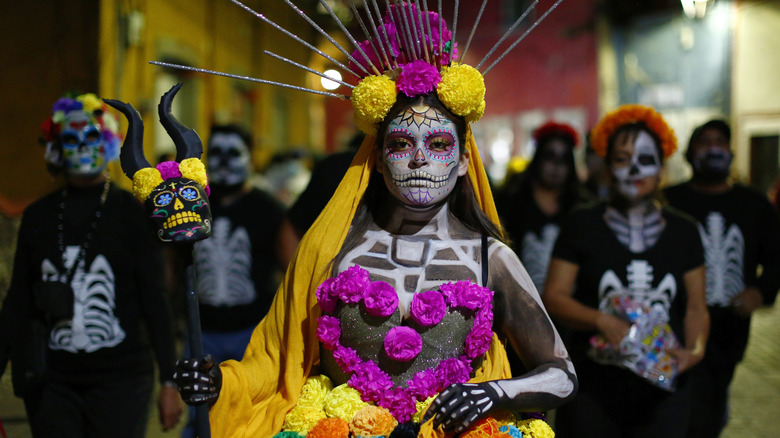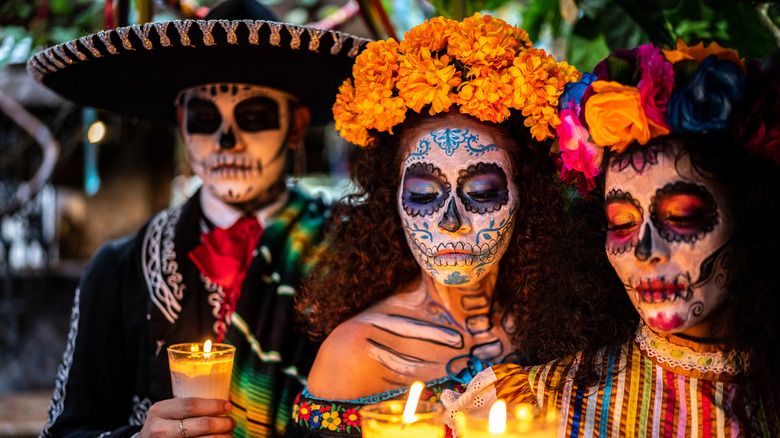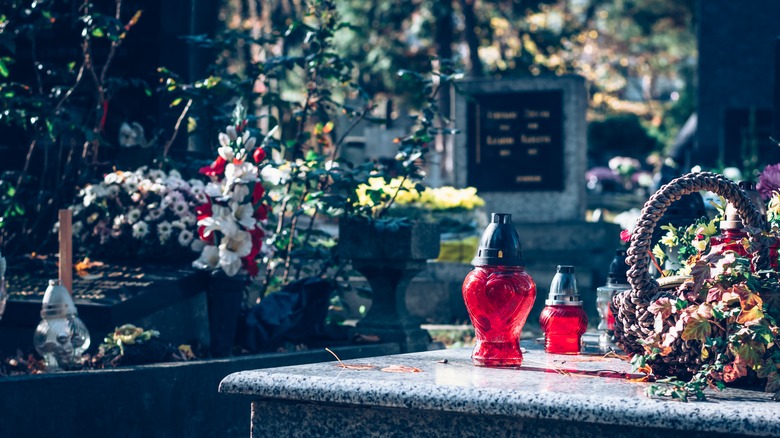What's The Difference Between Day Of The Dead And All Souls Day?
All Souls Day and the last day of Dia de los Muertos (also known as Day of the Dead) fall on November 2 each year, but what is the actual difference between the two holidays? Both traditions take place in the fall and revolve around the dead, so it's easy to get them mixed up. However, the main difference between the two is the purpose of the day. All Souls Day is a time when family and friends remember the deceased in purgatory and pray for their souls to help cleanse them of sin and ensure they can enter heaven. In contrast, Dia de los Muertos celebrates the dead by leaving food and gifts at the graves of loved ones as offerings to the deceased. While the various activities and celebrations on Day of the Dead are done to remember those who have passed on, they are also intended as a way to embrace death and become accustomed to the idea of it.
All Souls Day does not embrace death this way, though it does heavily revolve around those who are dead. It's important to keep in mind that neither day should be used as an excuse to dress up in Halloween costumes. Both All Souls Day and Dia de los Muertos are deeply important in their respective communities, and feature traditions that stem from long and varied histories.
Dia de los Muertos celebrates rather than mourns the dead
Day of the Dead's origins go back about 3,000 years to the ancient cultures of the Mesoamericans who saw death as a cyclical part of life and created rituals to help those who had passed on in their journey through the afterlife. Today, the traditions have evolved and those who celebrate Dia de los Muertos often paint their faces with skull imagery. One of the most recognizable figures people dress up as is "La Calavera Catrina," a skeleton dressed in fancy clothing. Per History, an artist named José Guadalupe Posada created "La Catrina" in 1910 and published a pamphlet of the same name in 1911. Within the pamphlet, Posada wrote, "Those garbanceras who today are coated with makeup will end up as deformed skulls." Though Posada was probably referencing the impending Mexican Revolution, it is also a fitting message for Dia de los Muertos — no matter how we live, we will all die in the end.
A typical Dia de los Muertos celebration involves bringing food and drink to the grave of a loved one to celebrate their memory. Aside from going to visit their grave, people celebrate their deceased loved ones by creating altars with photos and trinkets. Also known as ofrendas, these altars act as a welcome call to the dead so they can join in the festivities. The held belief is that the dead can inflict either prosperity or misfortune on their loved ones. The more effort that is put into celebrating the dead, the more likely they are to bestow the former rather than the latter.
All Souls Day has a similar theme but does not carry the same celebratory feel
On the other hand, All Souls Day is more of a somber occasion overall. Primarily a Roman Catholic tradition, it dates all the way back to the 11th century and is dedicated to those who are in purgatory. Purgatory is a temporary state in which those who have died have been accepted into God's grace but still need to atone for past sins. As part of All Souls Day, prayers are held in the hopes those in a state of purgatory can be accepted fully into heaven. Like Dia de los Muertos, it is common to visit graves on this day. Nevertheless, the intention of the visit is different, as it is not to celebrate or invite the dead.
Per The Economic Times, priests wear different colors on All Souls Day to show varying emotions and states — black for mourning, violet for penance, and white to signify hope for resurrection. As part of the day, churches will read out "The Church of the Dead," a prayer that dates all the way back to the 7th century AD. If you find yourself getting mixed up between Dia de los Muertos and All Souls Day, the easiest way to remember is that the former celebrates the dead in hopes of prosperity, whereas those who partake in the latter pray for the release of the dead from purgatory into heaven.


